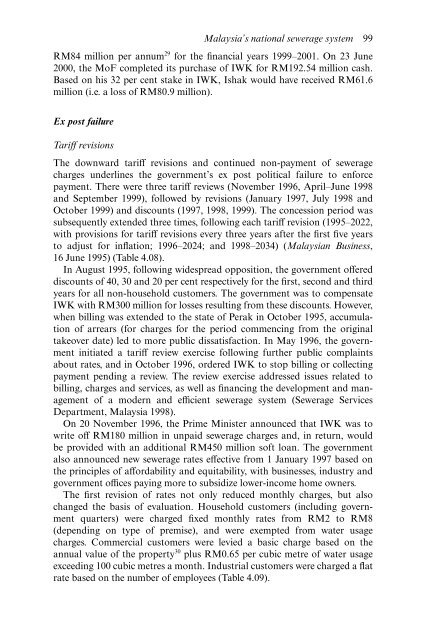PRIVATIZATION Privatization in Malaysia, Regulation, rent-seeking and policy failure
PRIVATIZATION Privatization in Malaysia, Regulation, rent-seeking and policy failure
PRIVATIZATION Privatization in Malaysia, Regulation, rent-seeking and policy failure
You also want an ePaper? Increase the reach of your titles
YUMPU automatically turns print PDFs into web optimized ePapers that Google loves.
<strong>Malaysia</strong>’s national sewerage system 99RM84 million per annum 29 for the f<strong>in</strong>ancial years 1999–2001. On 23 June2000, the MoF completed its purchase of IWK for RM192.54 million cash.Based on his 32 per cent stake <strong>in</strong> IWK, Ishak would have received RM61.6million (i.e. a loss of RM80.9 million).Ex post <strong>failure</strong>Tariff revisionsThe downward tariff revisions <strong>and</strong> cont<strong>in</strong>ued non-payment of seweragecharges underl<strong>in</strong>es the government’s ex post political <strong>failure</strong> to enforcepayment. There were three tariff reviews (November 1996, April–June 1998<strong>and</strong> September 1999), followed by revisions (January 1997, July 1998 <strong>and</strong>October 1999) <strong>and</strong> discounts (1997, 1998, 1999). The concession period wassubsequently extended three times, follow<strong>in</strong>g each tariff revision (1995–2022,with provisions for tariff revisions every three years after the first five yearsto adjust for <strong>in</strong>flation; 1996–2024; <strong>and</strong> 1998–2034) (<strong>Malaysia</strong>n Bus<strong>in</strong>ess,16 June 1995) (Table 4.08).In August 1995, follow<strong>in</strong>g widespread opposition, the government offereddiscounts of 40, 30 <strong>and</strong> 20 per cent respectively for the first, second <strong>and</strong> thirdyears for all non-household customers. The government was to compensateIWK with RM300 million for losses result<strong>in</strong>g from these discounts. However,when bill<strong>in</strong>g was extended to the state of Perak <strong>in</strong> October 1995, accumulationof arrears (for charges for the period commenc<strong>in</strong>g from the orig<strong>in</strong>altakeover date) led to more public dissatisfaction. In May 1996, the government<strong>in</strong>itiated a tariff review exercise follow<strong>in</strong>g further public compla<strong>in</strong>tsabout rates, <strong>and</strong> <strong>in</strong> October 1996, ordered IWK to stop bill<strong>in</strong>g or collect<strong>in</strong>gpayment pend<strong>in</strong>g a review. The review exercise addressed issues related tobill<strong>in</strong>g, charges <strong>and</strong> services, as well as f<strong>in</strong>anc<strong>in</strong>g the development <strong>and</strong> managementof a modern <strong>and</strong> efficient sewerage system (Sewerage ServicesDepartment, <strong>Malaysia</strong> 1998).On 20 November 1996, the Prime M<strong>in</strong>ister announced that IWK was towrite off RM180 million <strong>in</strong> unpaid sewerage charges <strong>and</strong>, <strong>in</strong> return, wouldbe provided with an additional RM450 million soft loan. The governmentalso announced new sewerage rates effective from 1 January 1997 based onthe pr<strong>in</strong>ciples of affordability <strong>and</strong> equitability, with bus<strong>in</strong>esses, <strong>in</strong>dustry <strong>and</strong>government offices pay<strong>in</strong>g more to subsidize lower-<strong>in</strong>come home owners.The first revision of rates not only reduced monthly charges, but alsochanged the basis of evaluation. Household customers (<strong>in</strong>clud<strong>in</strong>g governmentquarters) were charged fixed monthly rates from RM2 to RM8(depend<strong>in</strong>g on type of premise), <strong>and</strong> were exempted from water usagecharges. Commercial customers were levied a basic charge based on theannual value of the property 30 plus RM0.65 per cubic metre of water usageexceed<strong>in</strong>g 100 cubic metres a month. Industrial customers were charged a flatrate based on the number of employees (Table 4.09).


